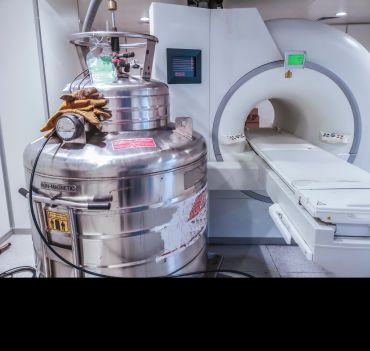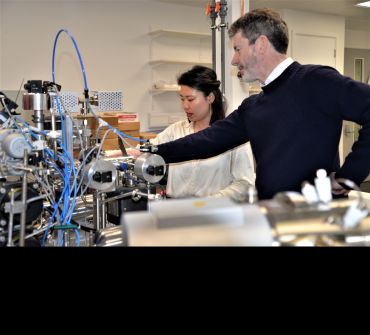New study could help pinpoint hidden helium gas fields – and avert a global supply crisis
Friday 24th Feb 2023, 12.41pm
 Helium gas is essential for many essential functions, including the operation of MRI scanners. Image credit: Shutterstock.
Helium gas is essential for many essential functions, including the operation of MRI scanners. Image credit: Shutterstock.Dr Anran Cheng (Department of Earth Sciences, University of Oxford), lead author of the study, said: ‘Our model shows the importance of factoring in the high diffusivity of helium and the long timescales needed to accumulate significant gas quantities, and the fact that the entire geological system acts dynamically to affect the process. This model provides a new perspective to help identify the environments that slow helium gases down enough to accumulate in commercial amounts.’
Where rare helium-rich underground gas fields have been found, they always occur alongside high concentrations of nitrogen gas. Until now, there has been no explanation for this. For the first time, this new study, which also involved the University of Toronto and Durham University, provides an answer.
The research team built a model to account for these helium-rich deposits by (for the first time) factoring in the presence of nitrogen, which is also released from the deep crust along with helium. The authors identified the geological conditions where the concentration of nitrogen becomes high enough to create gas bubbles in the rock pore space.
Such a process can take hundreds of millions of years, but when it happens the associated helium escapes from the water into the gas bubbles. These bubbles rise, because of buoyancy, towards the surface until they hit a rock type that doesn’t allow the bubbles through. According to the model, the helium-rich gas bubbles then collect beneath the seal and form a substantial gas field. The nitrogen and helium-rich gases contain no methane or carbon dioxide so tapping them does not release carbon emissions.
 Dr Anran Cheng (lead author, left) and Professor Chris Ballentine (right) preparing equipment for measurement of helium isotopes in geological samples. Image credit: Sarah Hilton.
Dr Anran Cheng (lead author, left) and Professor Chris Ballentine (right) preparing equipment for measurement of helium isotopes in geological samples. Image credit: Sarah Hilton.
When the researchers applied the model to an example system (Williston Basin, North America) using expected nitrogen concentration values, the model predicted the observed nitrogen/helium proportions in real life. The model could help identify areas likely to contain similar helium-rich deposits.
Helium is a $6 billion (£5.3 billion) market, with the gas being essential for the operation of MRI scanners, computer chips and fibre optic manufacture, and state of the art nuclear and cryogenic applications. A current global shortage has pushed supplies almost to a crisis point, with prices skyrocketing in recent years. The situation has been escalated by the Ukraine war, since this ruled out helium being supplied from the new Russian Amur plant, planned to supply 35% of the global helium demand.
In addition, almost all helium today is a by-product of methane or carbon dioxide natural gas production. This carries a significant carbon footprint and hinders ambitions to achieve net-zero carbon emissions by 2050.
Together, these reasons mean that identifying alternative, carbon-free sources of natural helium has become critically important.
The model also suggests regions where large amounts of hydrogen gas may accumulate underground, since the radioactivity that generates helium also splits water to form hydrogen. With a global market of $135 billion, hydrogen is used to create fertiliser and to produce many compounds essential for the food, petrochemical, and pharmaceutical industries. Virtually all hydrogen gas is currently produced from coal and natural gas (methane), and this alone accounts for 2.3% of global CO2 emissions. Hydrogen-rich underground deposits could provide an alternative carbon-free source.
The study is a crossover between exciting fundamental science – a new concept in understanding how the earth works – and potential industrial applications to help discover resources, such as helium and hydrogen, that will make a difference for society.
Dr Anran Cheng, Department of Earth Sciences, University of Oxford.
Professor Chris Ballentine (Department of Earth Sciences, University of Oxford), co-author for the study, noted: ‘The amount of hydrogen generated by the continental crust over the last 1 billion years would be enough to power society’s energy needs for over 100,000 years. Much has escaped or reacted but evidence also suggests enough remains to be a significant clean energy resource and controlled by similar process to the helium here.’
Since the appointment of Professor Ballentine in 2013 as chair of Geochemistry, the Oxford Earth Science Department has grown a substantial team who specialise in laboratory analysis and modelling capability in the field of geological fluids. Notable previous successes from the group include breakthroughs in groundwater security and carbon sequestration.
Dr Anran Cheng added: ‘We plan to test and apply this model to helium exploration in more complex geological systems, including rift basins where the flux of gases from the deep crust can vary, affecting the timing and size of gas field formation. We will also extend the conceptual model to include hydrogen, a potentially untapped clean energy source.’
The paper ‘Primary N2-He gas field formation in intracratonic sedimentary basins’ has been published in Nature.
A more technical description of this research can be found on the Department of Earth Sciences website.
The study also involved researchers from Durham University and the University of Toronto.

